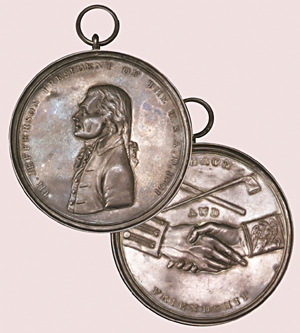|
"Making Cents"
The Signal
Saturday, July 29, 2006
| F |
It was the practice especially among Indians of the Great Lakes area, the Ohio Valley and the territories of Ohio, Kentucky and Tennessee to bring gifts such as salt, tobacco, weapons and blankets when visiting a tribal settlement. By honoring the chief with a silver medal, varying in size from that of a silver dollar to much larger pieces more than 50 mm in diameter — it bestowed significance to the chief's already lofty status. Naturally, rival tribes would vie for such honors and the British apparently made wide use of their peace (aka friendship) medals.
Upon American independence, the practice continued with American military units and explorers who ventured into Indian territories. Encountering friendly tribes, the peace medal became a link between the donor and the recipient; although the Indians could not read, they could tell this was a very significant award and it was cherished.
George Washington authorized several such medals, made in an oval shape specifically for certain tribal leaders in the western regions of existing states. A very few of these oval silver pieces exist today.
In a recent auction in Pennsylvania, a 1754 British peace medal sold for $102,000 — a record for one of these historic pieces. When John J. Ford died last year, his massive collection of early Americana started to come on the market. Stack's of New York recently featured photos of several of the peace medals in his estate, including a George III piece, a large-sized Thomas Jefferson, a John Tyler and the very rare private peace medal of famous fur merchant John Jacob Astor. Astor's portrait appears on one side and the traditional clasped handshake with a peace pipe and a tomahawk, crossed, appears above (as well as below).
Since the language was not intelligible to the Indians, the portrait carried great significance, since many Indians regarded human features as sacred.
The total number of peace medals is unknown, but for each type perhaps only one or a handful are known. All are slightly used (worn). All come with a metal loop or a hole to be worn with a chain or cord.
The American presidential series includes the words "Peace" and "Friendship," neither of which could be read by the chiefs. The British versions were inscribed in Latin — again of no meaning to the Indians. No doubt these medals were worn until the chief died; they were probably buried with the chief. In some cases of "passing the torch," some medals may have been handed down to successors.
There is no directory of all those who received such medals, or how many reside in private collections today. Probably most pieces are housed in museums. It may be possible that a few chiefs received both a British and an American medal in their lifetime. The practice ended by the mid-19th century.
The U.S. pieces were designed by U.S. Mint designers and executed at the Philadelphia Mint (except the Washington pieces, which were hand-engraved).
For some years, the U.S. Mint restruck some of these medals in silver as well as bronze. The restrikes have very little value as compared to the originals. If you happen to own one, get an expert opinion before considering insuring it or selling it.
Dr. Sol Taylor of Sherman Oaks is president of the Society of Lincoln Cent Collectors and author of The Standard Guide to the Lincoln Cent. Click here for ordering information.
©2006, THE SIGNAL · ALL RIGHTS RESERVED.

![[Most Recent Quotes from www.kitco.com]](http://www.kitconet.com/images/quotes_special.gif)

